Flip through your favorite firearm catalog and chances are that there are more rifles chambered in 5.56 NATO/.223 Remington than most others. Both rounds have gained in popularity with the rise of the AR-15, but are equally at home in bolt actions, single-shots, and even some lever guns. Both rounds are inexpensive, light-recoiling, yet at home for personal defense and some hunting applications. But with so many rifles out there, the labeling can get confusing. Is the 5.56 the same as the .223, but not metric? Or are both rounds completely different? And if so, is it enough to matter?
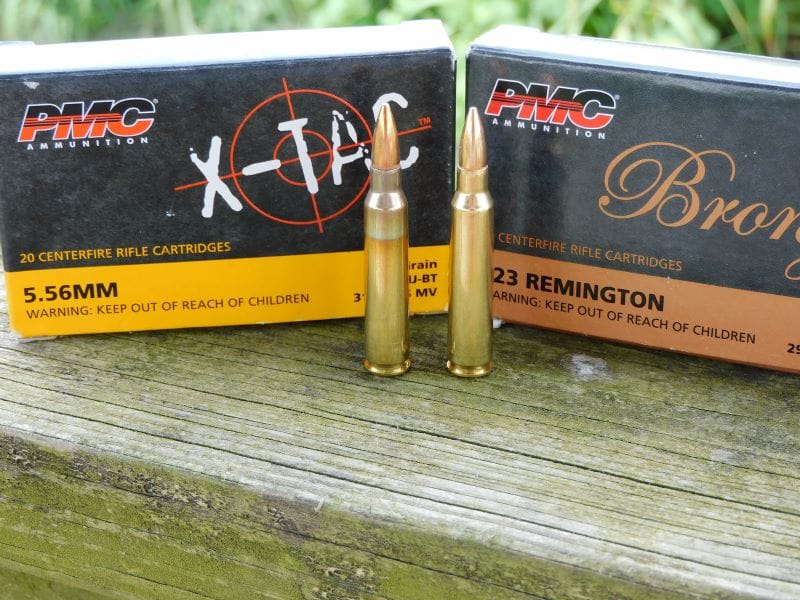
The debate about the differences between the 5.56 NATO and the .223 Remington has been raging for decades. Some say there are differences, but not enough to matter. Others claim the mixing and matching of firearms and ammunition can result in potential danger to the shooter. But when all the talk is said and done, is there a bottom line? People have used both cartridges for years and there are plenty of rifles out there that come from the factory that will shoot both. I always found the debate both pointless and curiously confusing, so I set out to find out the practical differences between the 5.56 NATO and the .223 Remington. Through a combination of history, ammo dissection, and shooting, I wanted to learn something and pass on another data point for you to use.
History
The .223 Remington
The fledgling United States Air Force got its footing as an independent branch during the Korean War (1950-53). Although the USAF would quickly dominate the skies from Pusan to the Yalu, the weapons training of the vital ground components left much to be desired. After that conflict, Gen. Curtis Lemay spearheaded an armaments program to equip his airmen with modern firearms that were easier to use. He pitched the idea of a high velocity .22 caliber rifle to the industry, and Remington responded with the .223 round that would be chambered in an experimental Armalite rifle. The .223 closely resembles the .222 Remington varmint cartridge, but the new round would, per Lemay’s requirements, retain supersonic velocities beyond 500 yards. The .223 Remington used a 55-grain projectile traveling at about 3,200 feet per second out of a 20-inch barrel. LeMay ordered the first .223 caliber ARs for service in 1960. The Army eventually adopted the new round and rifle in 1964. Somewhat confusingly, the new round was labeled 5.56 M193.
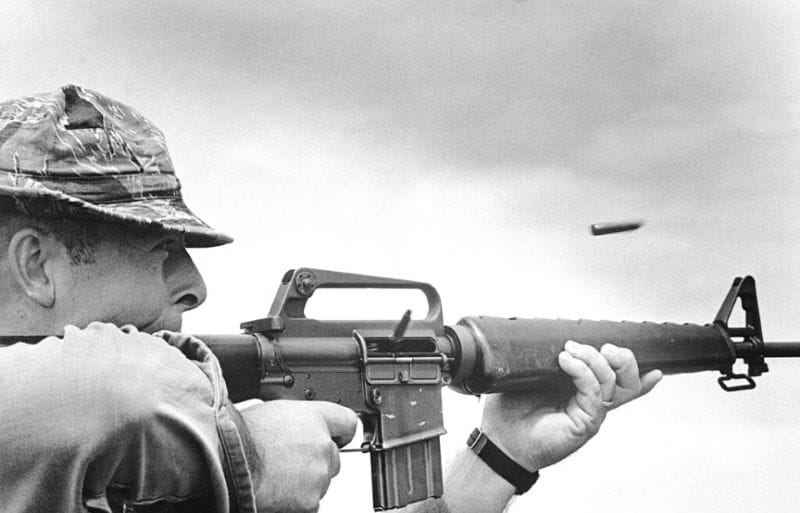
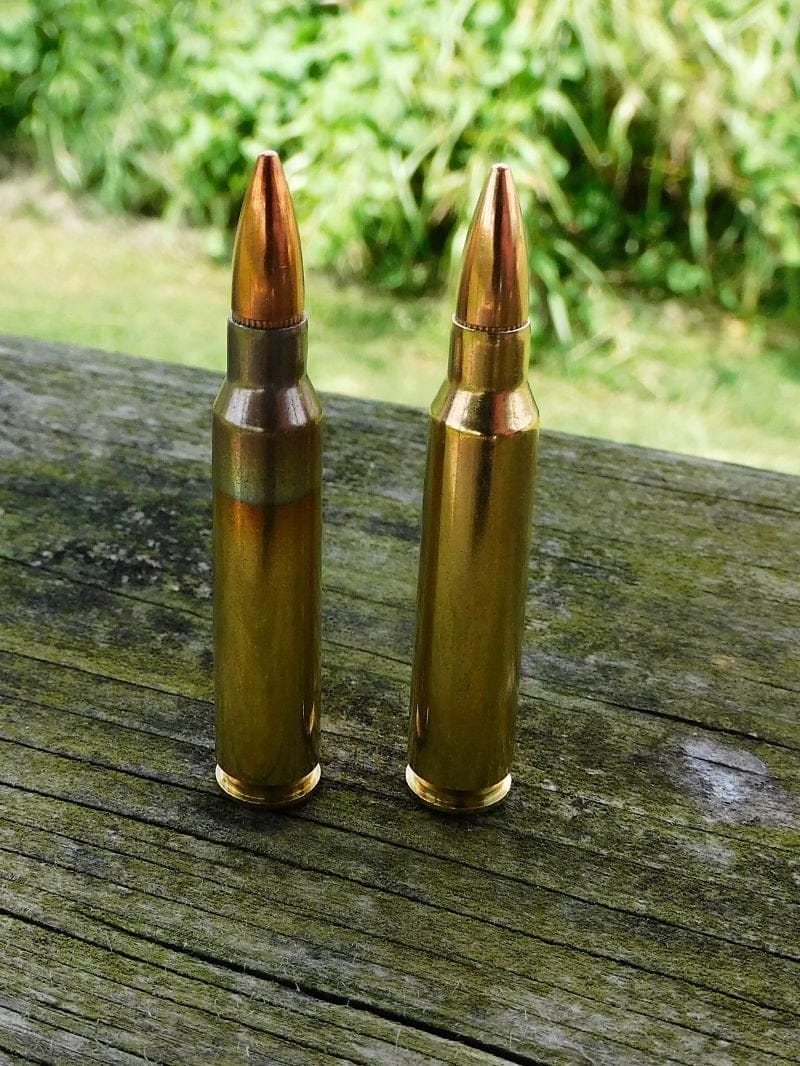
The 5.56x45mm NATO
Due to political pressure from the United States, the countries that made up the NATO alliance abandoned attempts to develop a lighter cartridge in favor of the 7.62×51 NATO round. Now that the United States abandoned the round in favor of the .223, NATO’s interest in an intermediate round was revived. In 1970, NATO agreed to find a smaller-caliber rifle round to replace the 7.62 NATO. The Belgian consortium FN developed their 5.56x45mm NATO round based on the .223 Remington. The round used a 62-grain full metal jacket round that was traveling slightly slower, but had a better ballistic coefficient (length of the bullet) to buck the wind at longer distances. The Belgian SS109 round was adopted by NATO in 1980. The 5.56 NATO has since come along in a number of variations from 55-grain M193 loads to 77-grain match loads designed for better long-range performance.
Case by Case
The 5.56 NATO and .223 Remington are largely interchangeable. It is generally understood that .223 Remington rounds will fire and shoot in 5.56 NATO chambered rifles. However, there is plenty of lore out there that 5.56 NATO ammunition should never be fired in a rifle chambered in .223 Remington. Why is that? It comes down to the internal and external differences in their cases and the chambers they go into. The differences are small, but important.
| 5.56x45mm NATO | .223 Remington | |
| Projectile Diameter | .224 inch | .224 inch |
| Shoulder Diameter | .354 inch | .354 inch |
| Cartridge Base Diameter | .377 inch | .376 inch |
| Rim Diameter | .378 inch | .378 inch |
| Rim Thickness | .045 inch | .045 inch |
| Case Length | 1.760 inch | 1.760 inch |
| Case Capacity | 28.5 grains H2O | 28.8 grains H2O |
The 5.56 NATO has a slightly larger cartridge base and less case capacity than the .223 Remington. The 5.56 NATO is designed to handle higher pressures with a given powder charge and was initially designed to fire somewhat heavier projectiles. Military-spec 5.56 NATO rounds also use staked primers to prevent primer failure, while the .223’s small rifle primer is seated by friction alone. Although there is some historical overall overlap between the rounds, the 5.56 has a SCATP rated pressure of 55,000 psi, while SAAMI rates the .223 at 55,000. Overwise, the 5.56 and .223 share the same bullet diameter, rim diameter, and case length.
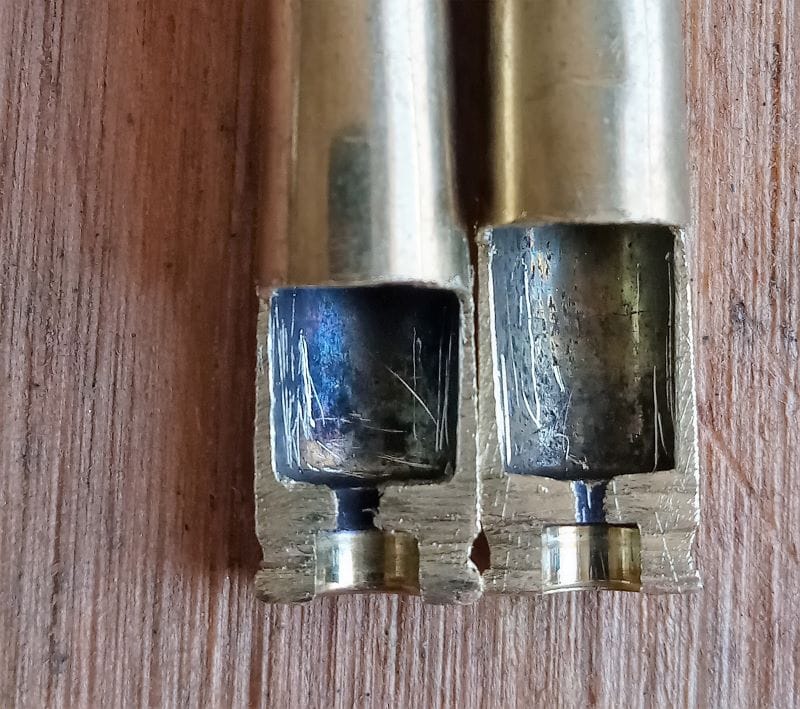
Depending on the manufacture of the brass, the 5.56 NATO will have noticeably thicker brass, which limits the internal case volume. I bisected two fired PMC 5.56 and .223 cases. Each had identical case brass thickness, but the 5.56 has a reinforced case head. The 5.56’s thicker construction and the use of crimped primers in military ammunition are to allow some forgiveness when fired in military rifles with questionable headspace.
The real issue between 5.56 and .223 is not one of pressure per se, but of how the case and bullet fit the chamber. A rifle in 5.56 NATO will nominally have a chamber that is reamed at the throat .125 inch longer than the .223. If a .223 Remington is fired in a 5.56 NATO chamber, the amount of travel the bullet must go from case to rifling is longer and there is a potential loss of pressure and a build-up of fouling at that point. This is immaterial for most shooting. But a dedicated .223 Remington does not have this longer throat. The bullet from a 5.56 NATO can engage the rifling with no travel at all. This results in extra chamber pressure, although how much is up for debate. Hornady states that using 5.56 in a .223 chamber can result in pressures as high as 65,000 psi. This is somewhat higher than even the old CIP rating for the .223, which is 62,300 psi.
While the 5.56 NATO round is better able to handle the pressures, SAAMI recommends against using 5.56 in a .223 chambered rifle. While it is best to exercise some caution, modern rifles are overbuilt. The lore of destroyed guns should be taken with a grain of salt and any use of 5.56 NATO should be accompanied by checking empty cases for signs of failure. Some shooters are completely against using 5.56 NATO in a .223. Some say it is perfectly fine.
Velocity Differences
The case dimensions of the 5.56 NATO and .223 Remington are slight, but important to keep in mind depending on the type of gun and ammunition you choose. Technically, the .223 has more powder capacity that, in theory, can translate to more power. In a match capacity, sticking to the cartridge the rifle is chambered for can eek out a bit more potential accuracy.
But most of us aren’t rolling these rounds on a press or conducting precision target practice. Chances are, we are dealing with off-the-shelf rifles and off-the-shelf ammunition. To test the more material differences between the 5.56 and .223, power and accuracy, I grabbed four common off-the-shelf ammunitions. I selected Frontier .223 and 5.56 NATO, as well as PMC Bronze .223 and PMC X-Tac 5.56. All of these loads use a 55-grain XM193 boattail full metal jacket bullet. These are inexpensive, brass-case loads that are easy to stockpile in quantity, so I also stuck with a rifle that is as common: a Smith & Wesson M&P 15 carbine with a 16-inch barrel.
To get an idea of how powerful each round is out of a typical rifle, I shot the four loads over my Caldwell Chronograph from a distance of 10 yards away. I fired five rounds of each and averaged the results. Despite the higher case capacity of the .223, it was the 5.56, with its slightly thicker case and higher resulting pressure, that produced higher velocities. The most powerful load was the Frontier 5.56 with an average velocity of 3,121 feet per second. The PMC X-Tac 5.56 was slightly behind at 3,059. The Frontier and PMC .223 loads clocked in at 2,946 and 2,891 feet per second, respectively. The pressure loss of .223 Remington fired from my 5.56 rifle will result in lower velocities, but I doubt it would result in a nearly 200-feet-per-second loss. The .223 Remington is a touch less powerful.
Accuracy
Accuracy between the 5.56 NATO and the .223 Remington is going to vary from one load to the next and one rifle to the next. The .223 does have the advantage of having more match ammunition available, but 5.56 NATO ammunition can be quite accurate. My particular rifle is chambered in 5.56 NATO and has a 1:9 twist that is best served with standard M193 55-grain FMJ ammunition.
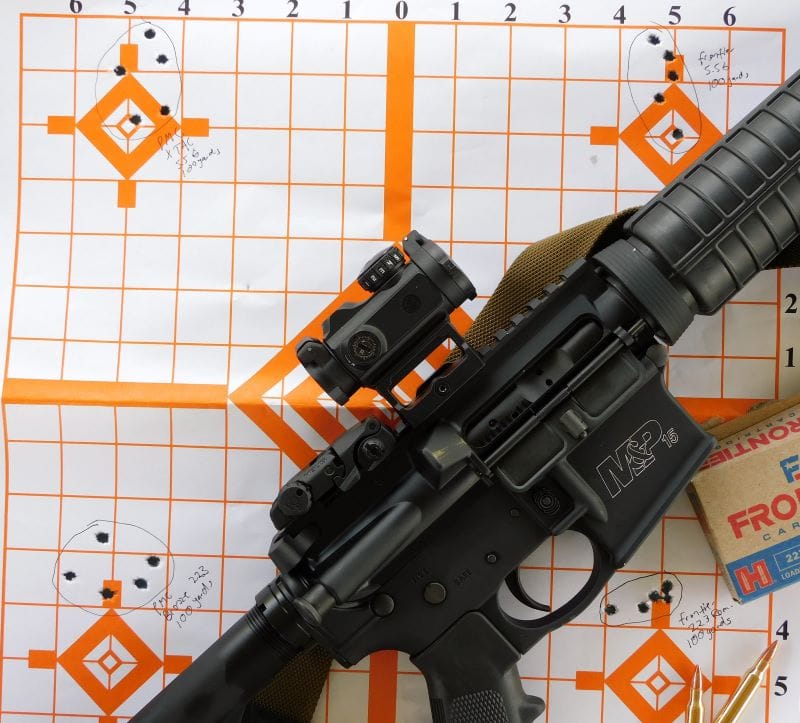
I shot 12 five-round groups using the same four types of ammunition used in the velocity test. The distance was 100 yards, shooting from a bench rest to take as much of me out of the equation as possible. The Sig MSR red dot is not the ultimate optic for tight groups, but I could consistently put up groups inside of two inches at that distance.
My best groups consistently went to the .223. My standard load, the PMC Bronze .223, came in 1.7 inches. But I found a new favorite load in the Frontier .223, which was consistently more accurate. My best group came in at 1.2 inches. The 5.56 PMC and Frontier loads came in at 1.8 and 1.9 inches respectively. In other 5.56 NATO rifles, I always found .223 Remington ammunition shot more accurately, but your mileage can vary.
The Bottom Line
Although there are bigger, badder, and more efficient cartridges out there, the 5.56 NATO and .223 Remington are popular with good reason. Both rounds are effective, easy to control, and have enough power for all but the largest tasks. When it comes to selecting one or the other, the user with a 5.56 NATO chambered rifle can best be served by trying both. Barring obvious signs of pressure differences, the user with the .223 rifle can probably make good use of 5.56 NATO ammunition as well. I have done this, but just because I have done it without an issue, doesn’t mean problems can arise. I don’t recommend it. But we can get lost in the minutia of ammunition compatibility when we should be more concerned with performance.
The bigger issue is selecting the right round that prints good groups and delivers good performance on the target. If you want a round to stockpile, both can suffice, but 5.56 NATO surplus loads are cheap. Likewise, the 5.56 will generally give higher velocity. But the .223 is not far behind in the power department and has a greater availability of match and hunting loads — although these rounds will command a premium. I found there to be little practical difference between the 5.56 NATO and the .223 Remington, but depending on how you shoot and what you shoot, what differences there are can make the difference.

